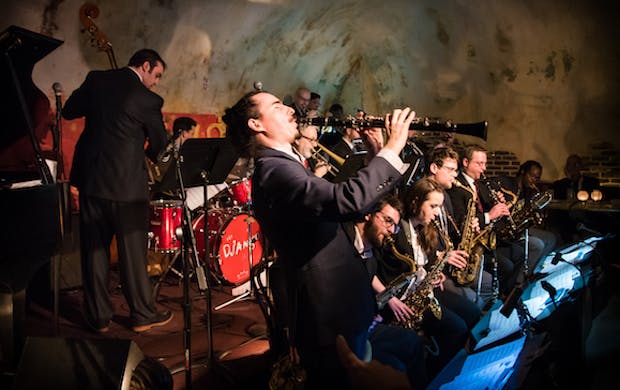Late Shows Helped Spawn the Latest in Swing
Eyal Vilner, the Tel-Aviv born bandleader, composer, arranger, and multiple reed player, utilizes various combinations of old wine and new bottles.

Eyal Vilner Big Band
‘The Jam’
Throughout the mid-2000s, Dizzy’s Club made a point of encouraging younger musicians to come and play during the late sets on weeknights. These performances were sometimes scheduled, sometimes completely spontaneous; some artists were paid, and many others just sat in. While a lot of these student players were then enrolled at either Juilliard or the Manhattan School of music, they probably learned more about traditional jazz and swing styles from the Dizzy’s jam sessions.
Many of us first heard of Eyal Vilner, the Tel-Aviv born bandleader, composer, arranger, and multiple reed player, from these Dizzy’s sessions. Mr. Vilner has been in New York for 15 years now, and just celebrated the release of the sixth album by his big band, titled “The Jam,” with a Sunday evening set at Birdland.
One reason it’s easy to love “The Jam” is the recording process — simple and straightforward. So many albums, including even those by contemporary jazz orchestras, seem overproduced, with what sounds like 20 microphones on every instrument, and they often achieve individual clarity but sacrifice the primary objective, which is for the individual sections to blend together into a cohesive ensemble. “The Jam” sounds like the band does in a live club (albeit without applause), with no apparent evidence of studio trickery such as overdubbing or autotuning.
Mr. Vilner specializes in the sounds of the Swing era and the period that came after, sometimes known as the late Swing era, thus spanning about 1935-1955. There are only two approximate recreations on the new album, Count Basie’s “Jumpin’ at the Woodside” and Jimmie Lunceford’s “T ‘aint What You Do.” Both feature new solos, and the latter has been retooled for a vocal by the excellent young singer Brianna Thomas.
For the most part, Mr. Vilner utilizes various combinations of old wine and new bottles, to paraphrase both the New Testament and Gil Evans. The majority of the compositions on “The Jam” are the leader’s new originals that draw heavily on the inspiration of music from the years before and after World War II. “Chad’s Delight” is an uptempo dance number that could have almost started life as a big-band treatment of “AirMail Special,” while “Monday Stroll” quotes Benny Golson’s “Social Call.”
“Another Time” takes its title literally; it starts in 2/4 with a piano solo by Jon Thomas that’s like Thelonious Monk paying homage to the stride tradition, and somewhere along the way it shifts into 4/4 swingtime. It goes back to two before the coda. “Will You Be My Quarantine?” is reminiscent of “Orange Colored Sky” and dozens of other period novelty songs, and is unabashedly cute: a tale of the pandemic with a ’40s flavor, enhanced by whistling from the band. Plenty of neo-Swing bands genuflect to Count Basie and Duke Ellington; Mr. Vilner’s is one of the few to evoke Ted Weems or Kay Kyser.
The band is rich in excellent young vocalists — and other attractions. “Will You Be My Quarantine?” is charmingly sung by Imani Rousselle, while Brianna Thomas also sings “Hard Hearted Hannah” on the album. Baritone Brandon Bain reprises the Al Hibbler hit “After The Lights Go Down Low,” and dancer Caleb Teicher placed a wooden board in front of the bandstand as a setup for his speciality, “Tap Tap Tap.” Most peeps in the house couldn’t see his tapping tootsies, but this art form is an auditory one as much as it is visual.
Mr. Vilner clearly is greatly inspired by the ideal of traditional social and swing dancing, which has led to several works for formal choreography commissioned by the Joyce Theater. “Belleville” is a gentle waltz that borrows a title from Django Reinhardt. The contrast of flute, played by Mr. Vilner, and muted brass momentarily made me think of Neil Hefti and Basie, except that the Count would never play anything in 3/4.
Mr. Vilner’s Israeli heritage came to the fore on “Bei Mir Bist Du Schoen,” the 1932 Yiddish song led by the leader on clarinet that is rendered in a much more klezmer fashion than its most famous interpreter, Benny Goodman, ever played it. Even though Mr. Vilner made his first album in 2010, the group still looks like a college band with the exception of two stalwart section players, trumpeter James Zollar and saxophonist Michael Hashim, who have been playing in big bands for as long as I’ve been hearing them.
Mr. Vilner draws heavily on the past, yet this is not a band where time stands still — just the opposite: It jumps, it moves, it swings.

